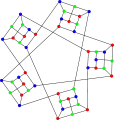Watkins snark
In the mathematical field of graph theory, the Watkins snark is a snark with 50 vertices and 75 edges.[1][2] It was discovered by John J. Watkins in 1989.[3]
| Watkins snark | |
|---|---|
 The Watkins snark | |
| Named after | J. J. Watkins |
| Vertices | 50 |
| Edges | 75 |
| Radius | 7 |
| Diameter | 7 |
| Girth | 5 |
| Automorphisms | 5 |
| Chromatic number | 3 |
| Chromatic index | 4 |
| Book thickness | 3 |
| Queue number | 2 |
| Properties | Snark |
| Table of graphs and parameters | |
As a snark, the Watkins graph is a connected, bridgeless cubic graph with chromatic index equal to 4. The Watkins snark is also non-planar and non-hamiltonian. It has book thickness 3 and queue number 2.[4]
Another well known snark on 50 vertices is the Szekeres snark, the fifth known snark, discovered by George Szekeres in 1973.[5]
Gallery
 The chromatic number of the Watkins snark is 3.
The chromatic number of the Watkins snark is 3. The chromatic index of the Watkins snark is 4.
The chromatic index of the Watkins snark is 4.
Edges
[[1,2], [1,4], [1,15], [2,3], [2,8], [3,6], [3,37], [4,6], [4,7], [5,10], [5,11], [5,22], [6,9], [7,8], [7,12], [8,9], [9,14], [10,13], [10,17], [11,16], [11,18], [12,14], [12,33], [13,15], [13,16], [14,20], [15,21], [16,19], [17,18], [17,19], [18,30], [19,21], [20,24], [20,26], [21,50], [22,23], [22,27], [23,24], [23,25], [24,29], [25,26], [25,28], [26,31], [27,28], [27,48], [28,29], [29,31], [30,32], [30,36], [31,36], [32,34], [32,35], [33,34], [33,40], [34,41], [35,38], [35,40], [36,38], [37,39], [37,42], [38,41], [39,44], [39,46], [40,46], [41,46], [42,43], [42,45], [43,44], [43,49], [44,47], [45,47], [45,48], [47,50], [48,49], [49,50]]
References
- Weisstein, Eric W. "Watkins Snark". MathWorld.
- Watkins, J. J. and Wilson, R. J. "A Survey of Snarks." In Graph Theory, Combinatorics, and Applications (Ed. Y. Alavi, G. Chartrand, O. R. Oellermann, and A. J. Schwenk). New York: Wiley, pp. 1129-1144, 1991
- Watkins, J. J. "Snarks." Ann. New York Acad. Sci. 576, 606-622, 1989.
- Wolz, Jessica; Engineering Linear Layouts with SAT. Master Thesis, University of Tübingen, 2018
- Szekeres, G. (1973). "Polyhedral decompositions of cubic graphs". Bull. Austral. Math. Soc. 8 (03): 367–387. doi:10.1017/S0004972700042660.